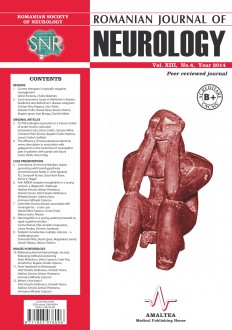SELECT ISSUE

Indexed

| |

|
|
|
| |
|
|
|

|
|
|
|
|
|
| |
|
|
HIGHLIGHTS
National Awards “Science and Research”
NEW! RJN has announced the annually National Award for "Science and Research" for the best scientific articles published throughout the year in the official journal.
Read the Recommendations for the Conduct, Reporting, Editing, and Publication of Scholarly work in Medical Journals.
The published medical research literature is a global public good. Medical journal editors have a social responsibility to promote global health by publishing, whenever possible, research that furthers health worldwide.
CD105/ENDOGLIN EXPRESSION IN A MOUSE MODEL OF ACUTE MUSCLE CONTUSION
Antoanela Curici, Elena Codrici, Simona Mihai, Cristiana Pistol Tanase, Bogdan Ovidiu Popescu and Laura Cristina Ceafalan
ABSTRACT
Objectives. Muscle contusion is the most common form of muscle injury and the muscle endogenous regenerative capacity can compensate for non-extensive damage. However, severe traumatic injuries may overcome this capacity. More effective therapeutic strategies are still needed, so the exploration of the molecular context during muscle regeneration might provide new insights.
Materials and methods. We investigated the expression pattern of a reputed angiogenic molecule, CD105/endoglin, by measuring the tissue and serum concentration by multiplex assay in normal and Dmdmdx dystrophic mice by following the distribution of the cellular sources by immunofluorescence in a mouse model of acute muscle contusion.
Results. Maximal tissue concentration in normal animals was obtained 48h post-injury, and then started to decline, with only one other significantly increased value 5 days after injury. In dystrophic mice, tissue levels were globally much higher than in normal animals and started rising 1h post-injury and were maintained elevated all along the regeneration process. In situ immunolabelling highlighted the increased positive population mostly in the inflammatory areas. Double staining separates distinct subsets based on hematopoietic marker CD45 and the endothelial marker CD31 co-expression in endoglin positive cells.
Conclusions. This study offers a timeline of endoglin expression during normal and pathologic muscle regeneration, providing evidence that the major wave corresponds to the inflammatory stage of muscle regeneration, deriving from multiple cellular sources such as endothelial cells, blood cells and also other interstitial cells that become activated during this process.
Keywords: angiogenesis, CD105, endoglin, muscle regeneration
Full text | PDF
